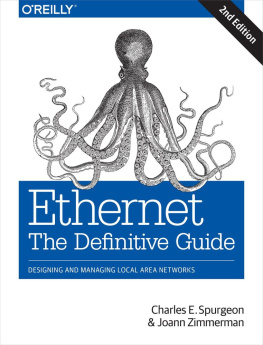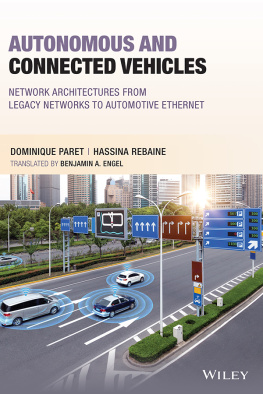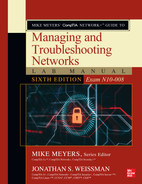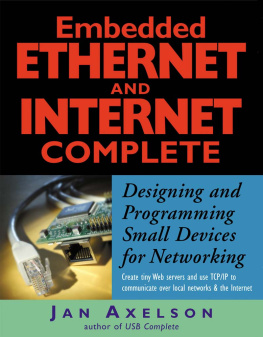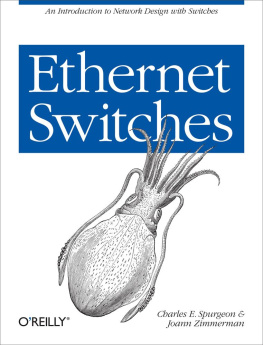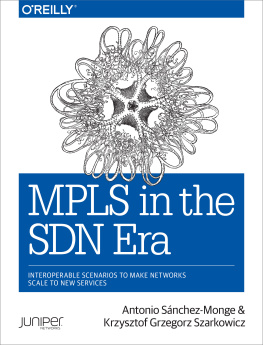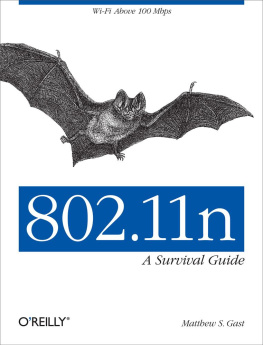Ethernet: The Definitive Guide
Charles E. Spurgeon
Joann Zimmerman
Preface
This is a book about Ethernet, the worlds most popular network technology, which allows you to connect a variety of computers together with a low-cost and extremely flexible network system. Ethernet is found on a wide variety of devices, and this widespread support, coupled with its low cost and high flexibility, are major reasons for its popularity.
The Ethernet standard has grown to over 3,700 pages, and it covers a multitude of Ethernet technologies designed for multiple environments. Ethernet is used to build home networks, office and campus network systems, as well as wide area networks that span cities and countries. There are Ethernet systems designed for networking a neighborhood, as well as Ethernets designed for networking inside automobiles to link the multiple computers found there these days.
The goal of this book is to provide a comprehensive and practical source for information on the most widely used Ethernet technologies in a single volume. This book describes the varieties of Ethernet commonly used in homes, offices, and campus networks, as well as several systems typically used in data centers and server machine rooms. These include the most widely used set of Ethernet media systems: 10 Mb/s Ethernet, 100 Mb/s Fast Ethernet, and 1000 Mb/s Gigabit Ethernet, as well as 10 Gigabit and 40 and 100 Gigabit Ethernet. We also describe full-duplex Ethernet, Ethernet Auto-Negotiation, Power over Ethernet, Energy Efficient Ethernet, structured cabling systems, network design with Ethernet switches, network management, network troubleshooting techniques, and more.
To provide the most accurate information possible, we referred to the complete set of official Ethernet standards while writing this book. Our experience includes working with Ethernet technology since the early 1980s, and many hard-won lessons in network design and operation based on that experience have made their way into this edition.
Ethernet Is Everywhere
Ethernet is the most widely used networking technology, and Ethernet networks are everywhere. There are a number of factors that have helped Ethernet to become so popular. Among these factors are cost, scalability, reliability, and widely available management tools.
Cost
The rapid evolution of new capabilities in Ethernet has been accompanied by an equally rapid decrease in the cost of Ethernet equipment. The widespread adoption of Ethernet technology created a large and fiercely competitive Ethernet marketplace, which serves to drive down the cost of networking components. The consumer wins out in the process, with the marketplace providing a wide range of competitively priced Ethernet components to choose from.
Scalability
The first industry-wide Ethernet standard was published over 30 years ago, in 1980. This standard defined a 10 megabits per second (Mb/s) system, which was very fast for the time. The development of the 100 Mb/s Fast Ethernet system in 1995 provided a tenfold increase in speed. Following on that success came the development of twisted-pair Gigabit Ethernet in 1999. Network interfaces that can automatically support 10, 100, and 1000 Mb/s operation of twisted-pair media systems are widely available, making the support of high-performance networking easy to accomplish.
Applications tend to grow to fill all available bandwidth. To manage the constant increase in network usage, the 10 Gigabit Ethernet standard was developed in 2002, and most recently the 40 and 100 Gigabit systems were standardized in 2010. All of this progress in Ethernet capabilities makes it possible for a network manager to provide high-speed backbone systems and connections to high-performance servers.
Desktop machines can be connected to an Ethernet link that can operate at 10 Mb/s Ethernet, 100 Mb/s Fast Ethernet, or Gigabit Ethernet speeds, as required. Network routers and switches can use 10 Gigabit and 40 or 100 Gigabit links for network backbones, and data centers can connect to high-performance servers at 10, 40, or even 100 gigabits per second (Gb/s).
Reliability
Ethernet is simple and robust and reliably delivers data day in and day out at sites all over the world. Ethernet based on twisted-pair media was introduced in 1987, making it possible to provide Ethernet signals over a structured cabling system.
Structured cabling provides a data delivery system for a building that is modeled on high-reliability cabling practices originally developed for the telephone system. This makes it possible to install a standards-based cabling system for Ethernet that is highly reliable and easy to manage.
Widely Available Management Tools
The widespread acceptance of Ethernet brings with it the wide availability of Ethernet management and troubleshooting tools. Management tools based on standards such as the Simple Network Management Protocol (SNMP) make it possible for network administrators to keep track of an entire campus full of Ethernet equipment from a central location. Management capabilities embedded in Ethernet switches and computer interfaces provide powerful network monitoring and troubleshooting capabilities.
Design for Reliability
A major goal of this book is to help you design and implement reliable networks, because network reliability is of paramount importance to users and organizations. Access to the Internet and information sharing between networked computers is an essential feature of todays world, and if the network fails, everything comes to a halt. This book shows you how to design reliable networks, how to monitor them and keep them working reliably, and how to fix them should something fail.
The wide range of Ethernet components and cabling systems available today provides enormous flexibility, making it possible to build an Ethernet to fit just about any circumstance. However, all this flexibility does have a price. The many varieties of Ethernet each have their own components and their own configuration rules, which can make the life of a network designer complex. Designing and implementing a reliable Ethernet system requires that you understand how all the bits and pieces fit together, and that you follow the official guidelines for the configuration of the media systems. To help you with that task, this book provides the configuration guidelines for the widely used media systems.
Downtime is Expensive
Avoiding network downtime is important for a number of reasons, not least of which is the cost of a network outage. Some quick back of the envelope calculations can show how expensive network downtime can be. Lets assume that there are 1,000 network users at the Amalgamated Widget Company, and that their average annual salary including all overhead (benefits, etc.) is $100,000. That comes to $100 million a year in employee costs.
Lets further assume that everyone in the company depends on the network to get their work done, and that the network is used 40 hours a week, for about 50 weeks of the year. Thats 2,000 hours of network operation. Dividing the annual employee cost by the hours of network operation shows that the network is supporting $50,000 per hour of employee cost during the year.
Lets further assume that when we total up all of the network outages over the period of a year in our hypothetical corporation, we find that the network was down just 1% of the time (99% uptime, or two nines). That sounds like really good uptime, but that small fraction of 2,000 hours represents a total of 20 hours of network outage. Twenty hours of network downtime at $50,000/hour is $1,000,000 in lost productivity due to network outage.

